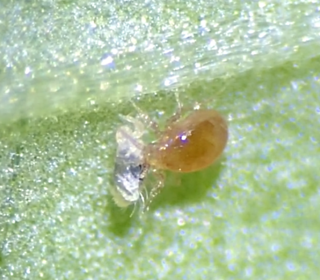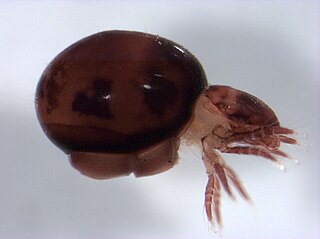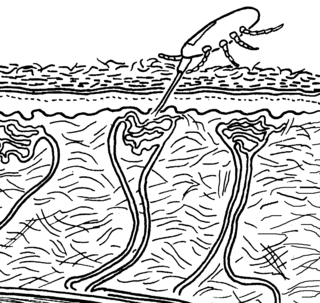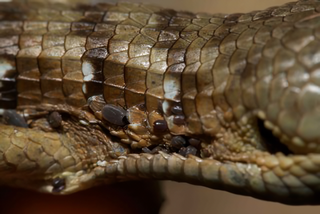
Mites are small arachnids. Mites span two large orders of arachnids, the Acariformes and the Parasitiformes, which were historically grouped together in the subclass Acari. However, most recent genetic analyses do not recover the two as each other's closest relative within Arachnida, rendering the group non-monophyletic. Most mites are tiny, less than 1 mm (0.04 in) in length, and have a simple, unsegmented body plan. The small size of most species makes them easily overlooked; some species live in water, many live in soil as decomposers, others live on plants, sometimes creating galls, while others are predators or parasites. This last type includes the commercially destructive Varroa parasite of honey bees, as well as scabies mites of humans. Most species are harmless to humans, but a few are associated with allergies or may transmit diseases.

Mange is a type of skin disease caused by parasitic mites. Because various species of mites also infect plants, birds and reptiles, the term "mange", or colloquially "the mange", suggesting poor condition of the skin and fur due to the infection, is sometimes reserved for pathological mite-infestation of nonhuman mammals. Thus, mange includes mite-associated skin disease in domestic mammals, in livestock, and in wild mammals. Severe mange caused by mites has been observed in wild bears. Since mites belong to the arachnid subclass Acari, another term for mite infestation is acariasis.

Parasitiformes are a superorder of Arachnids, constituting one of the two major groups of mites, alongside Acariformes. Parasitiformes has, at times, been classified at the rank of order or suborder.

The Phytoseiidae are a family of mites which feed on thrips and other mite species. They are often used as a biological control agent for managing mite pests. Because of their usefulness as biological control agents, interest in Phytoseiidae has steadily increased over the past century. Public awareness of the biological control potential of invertebrates has been growing, though mainly in the US and Europe. In 1950, there were 34 known species. Today, there are 2,731 documented species organized in 90 genera and three subfamilies.

Oribatida, also known as oribatid mites, moss mites or beetle mites, are an order of mites, in the "chewing Acariformes" clade Sarcoptiformes. They range in size from 0.2 to 1.4 millimetres. There are currently 12,000 species that have been identified, but researchers estimate that there may be anywhere from 60,000 to 120,000 total species. Oribatid mites are by far the most prevalent of all arthropods in forest soils, and are essential for breaking down organic detritus and distributing fungi.

Tydeidae is a family of acariform mites. As of 2016, it contained over 300 species in three subfamilies, though more species have been discovered since then.

Psoroptidia is a parvorder of the Acari (mite) group Astigma. It comprises around 40 families, and apparently originated as parasites of birds, before a secondary radiation saw some taxa become parasites of mammals. Because of their parasitic lifestyle, members of the Psoroptidia do not exhibit a deutonymph stage.
Leptotrombidium is a genus of mites in the family Trombiculidae, that are able to infect humans with scrub typhus through their bite. The larval form feeds on rodents, but also occasionally humans and other large mammals. They are related to the harvest mites of the North America and Europe.

Trombiculidae, commonly referred to in North America as chiggers and in Britain as harvest mites, but also known as berry bugs, bush-mites, red bugs or scrub-itch mites, are a family of mites. Chiggers are often confused with jiggers – a type of flea. Several species of Trombiculidae in their larva stage bite their animal host and by embedding their mouthparts into the skin cause "intense irritation", or "a wheal, usually with severe itching and dermatitis". Humans, being animals, are possible hosts.

Gamasoidosis, also known as dermanyssosis, is a frequently unrecognized form of dermatitis, following human infestation with avian mites of the genera Dermanyssus or Ornithonyssus. It is characterized by pruritic erythematous papules, macules and urticaria, with itching and irritation resulting from the saliva the mites secrete while feeding. These bites are commonly found around the neck and areas covered by clothing, but can be found elsewhere on the body. The avian mite Dermanyssus gallinae can also infest various body parts, including the ear canal and scalp.

Dermanyssoidea is a superfamily of mites, including most of the mites which parasitise vertebrates.
Ornithonyssus bursa is a species of mite. It is most often a parasite of birds, but also has been found to bite humans and two species of mammals. It usually lives in birds' feathers, but for laying its eggs, it more often uses their nests rather than their feathers. Tropical fowl mites undergo five stages during their development: egg, larva, protonymph, deutonymph, and adult. During the last two stages, they suck blood from their host for food. They are often diurnal, whereas northern fowl mites are nocturnal in nature.
Gigantolaelaps mattogrossensis is a mite from the Americas. It has been found on the marsh rice rat, hispid cotton rat, black rat, brown rat, and white-footed mouse in the United States. In Venezuela, it has been recorded from Holochilus brasiliensis, Sigmodon hirsutus, and Marmosa robinsoni. In Argentina, it has been found on Scapteromys aquaticus, Oligoryzomys flavescens, and Holochilus brasiliensis. The North American form was first described as a separate species, Gigantolaelaps cricetidarum, and is still occasionally considered as such.

Brevipalpus phoenicis, also known as the false spider mite, red and black flat mite, and in Australia as the passionvine mite, is a species of mite in the family Tenuipalpidae. This species occurs globally, and is a serious pest to such crops as citrus, tea, papaya, guava and coffee, and can heavily damage numerous other crops. They are unique in having haploid females, a condition caused by a bacterium that change haploid males into females.
Archegozetes longisetosus is a species of tropical moss mite in the family Trhypochthoniidae. It has been used as a model organism and has been found to have a very high pulling strength relative to its size.

Mites are small crawling animals related to ticks and spiders. Most mites are free-living and harmless. Other mites are parasitic, and those that infest livestock animals cause many diseases that are widespread, reduce production and profit for farmers, and are expensive to control.
Magdalena Kathrina Petronella Smith Meyer was a South African acarologist who was regarded as a world authority on plant-feeding mites of agricultural importance and was known as the "mother of red-spider mites of the world". She described more than 700 new species and 25 new genera, mostly of mites of agricultural importance. Meyer was involved in the promotion of biological control of mites using predatory mites, spiders and insects.

Kiwalges haastii is a species of New Zealand feather mite in the superfamily Analgoidea, known only from the great spotted kiwi, from which it derives its name.
Geckobia is a genus of parasitic mites in the family Pterygosomatidae.

A mite pocket is an area on the body of a lizard that where biting mites congregate such as chiggers and ticks. They are slight depressions on the body, usually behind other appendages such as the legs and neck. These areas have smaller scales and increased blood vessels to entice the parasites to move there, while also being able to regenerate itself quickly, thus localizing the damage to only one part of the lizard's body.














